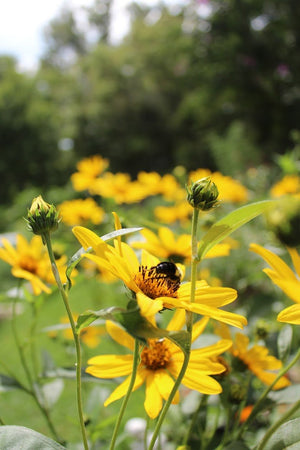Fall Garden Task Checklist


The weather may be cooler, but fall is a great time to plant! Warm soil and reliable autumn rainfall make for ideal planting conditions for perennial native plants. Since native plants are well suited to your area’s soil and weather, and can provide benefit to wildlife throughout winter, there’s only a few tasks to manage in the fall.
CONSIDER REPLACING LAWN OR ANNUALS WITH NATIVE PLANTS
Replacing conventional lawns can save time and money that you would normally spend on mowing and fertilizing grass. Native plants require much less maintenance than turf grass. Reducing your lawn in favor of densely planted garden beds helps minimize water runoff too. Choosing native plants that are adapted to regional rainfall and soil moisture content is a great way to conserve this precious resource.
LEAVE THE LEAVES
With the arrival of fall, you shouldn’t feel obligated to get rid of every last fallen leaf in your yard. Leave the leaves — they offer a lot of benefits for wildlife and your garden.
“Leaves form a natural mulch that helps suppress weeds and fertilizes the soil as it breaks down. Why spend money on mulch and fertilizer when you can make your own? Turning leaves into solid waste is, well, wasteful,” said National Wildlife Federation Naturalist David Mizejewski. “Removing leaves also eliminates vital wildlife habitat. Critters ranging from turtles and toads to songbirds, mammals and invertebrates rely on leaf litter for food, shelter and nesting material. Many moth and butterfly caterpillars overwinter in fallen leaves before emerging in spring. Also, sending organic matter such as leaves to the landfill causes the release of greenhouse gasses that contribute to climate change. Best of all, the less time you spend removing leaves, the more time you’ll have to enjoy the gorgeous fall weather and the wildlife that visits your garden.”
Learn more about what to do with fallen leaves.
MULCH & COMPOST
If you are leaving the leaves, you’re ahead of the game! From a gardening perspective, fallen leaves offer a double benefit. Leaves form a natural mulch that helps suppress weeds and at the same time fertilize the soil as they break down. If you let leaves lie where they fall or move them into your garden beds, they will protect your plants’ roots, suppress weeds, preserve soil moisture and eventually break down and return nutrients to the soil.
In this “off season,” you might also be lucky to find mulch on sale near you. A layer of mulch or compost can help your plants better retain moisture, and hold down weeds.
TRIMMING & DEADHEADING
Deadheading faded flowers and cutting back stems prevents plants from reproducing and can eliminate habitat for overwintering bees, caterpillars and other wildlife. If you can, leave some stems for the wildlife to utilize.
To add seasonal interest and provide food and shelter for wildlife during fall and winter, here are some tips for maintaining some of the late summer blooming plants in our collections:
- Wild Bergamot, Bee Balm (Monarda fistulosa): Leave final late summer bloom seed heads for birds.
- Red Cardinal Flower (Lobelia cardinalis) and Great Blue Lobelia (Lobelia siphilitica): Leave old flower spikes to help with reseeding for more bloom next year.
- Purple Coneflower (Echinacea purpurea): Allow the stalks and seed heads to remain all winter, they will provide structure in the garden and foods for birds and other wildlife.
- Black Eyed Susans (Rudbeckias): Cut low for winter after birds have had their seeds.
PREPARE SHRUBS FOR WINTER
While you’re enjoying the stunning shades of bronze, reds, and oranges from the foliage of your deciduous native shrubs, help them prepare for the colder temperatures of fall and winter. Add a layer of mulch to protect the roots from harsh weather, taking care that the mulch does not touch plant stems. Most native shrubs like Azaleas and Carolina Rose do not typically require pruning. However, you can prune dead, diseased, or damaged branches at any time, including in fall.
Find Native Plants by Zip Code
We took the guesswork out of planting native. Check your zip to see what ships!

